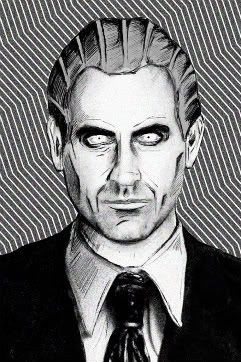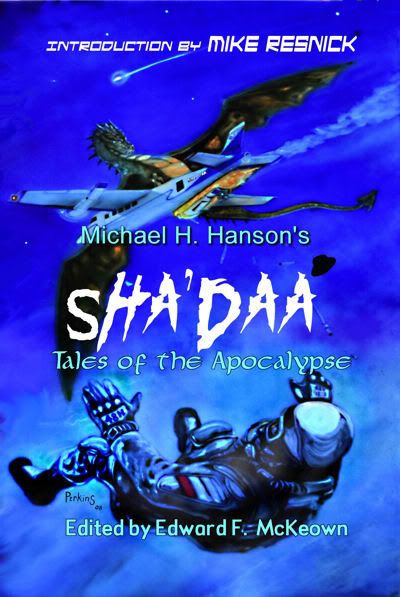An Interview with D. Harlan Wilson
conducted by M. Arkenberg

Of your three recent/upcoming books—Blankety Blank: A Memoir of Vulgaria; Technologized Desire: Selfhood & the Body in Postcapitalist Science Fiction; and Peckinpah: An Ultraviolent Romance—which has been the most enjoyable to write? The hardest?
Peckinpah and Blankety Blank were equally fun to write. Both are set in places where I’ve lived—Grand Rapids, Michigan, and Celina, Ohio—although I changed Celina to Dreamfield, Indiana. Sounds better. And it’s more suggestive. Anyway, I was able to explore my experiences, for better and for worse, in those places, and I had a good time satirizing the people that lived there. Both novels involved large measures of research, but nowhere near as much as Technologized Desire, a book of cultural and literary theory, which was definitely the hardest to write. It’s a culmination of about twelve years of research, drafting and revision. In it, I study and analyze postmodern science fiction films and novels in an attempt to develop a “postcapitalist” theory of selfhood, technology, subjectivity and the body. My primary texts include Cameron Crowe’s Vanilla Sky, William S. Burroughs’ cut-up trilogy, Sam Raimi’s Army of Darkness, Max Barry’s Jennifer Government, and the Wachowski Bros.’ Matrix trilogy. I read these texts by way of a wide variety of philosophies and theories on electronic media, image-culture, postmodernism, etc. It was a big undertaking. Part of me can’t believe I ever finished.
Technologized Desire is a work of criticism. Is this a new genre for you? Why did you decide to write it?
I’ve been writing criticism for awhile now. Technologized Desire is a revision of my Ph.D. dissertation, and I’m a college professor, so criticism comes with the territory. I’ve published several essays, mainly on films, and I write lots of book reviews for academic journals. In the wake of Technologized Desire, I’ve been contracted to write a book on John Carpenter’s They Live for UK publisher Wallflower Press’s cultographies series. I’ve always liked the interplay between writing fiction and nonfiction; they feed off of and sharpen one another.
What first attracted you to Bizarro fiction? What is the writing process like for this kind of story?
The term “Bizarro fiction” is actually something that emerged around my writing and the writing of a few other authors. I didn’t find Bizarro, in other words. You could say it found me.
Different people are attracted to Bizarro for different reasons. Some people just like weird, funny stuff, and to varying degrees of success and technical application, Bizarro is almost invariably weird and funny. Good Bizarro, however, is not simply that way for the sake of it. Personally, with my Bizarro texts, I try to test the limits of narrative, create and entertain irreal characters and worlds, represent the absurdity of mediatized society and culture, explore the vicissitudes of unconsciousness and desire, and critique the nature of technocapitalist (pseudo)reality. Above all, though, I want to entertain readers, and I want them to laugh, or at least smile. If they don’t, I’ve failed.
The writing process for Bizarro is the same as any other type of writing, for me anyway. No matter what sort of narrative I’m composing, I write best in the morning with coffee. I don’t write for long periods of time, but I try to write every day. With novels, I construct fairly detailed notes and outlines that I usually diverge from, but they make for good scaffolding and security. I don’t consciously try to think up strange or wacky things. I just write what I like. In fact, a lot of the writing I do is for my own entertainment. Most stories and books bore me. I’m aware of my shortcomings and inadequacies as an author, but if nothing else, I do think my writing is unique.
What can Bizarro fiction do that other genres can’t? Do you see any advantages in other genres over Bizarro fiction?
The best thing about Bizarro is deigetic, thematic and stylistic freedom. There are boundaries, primarily in terms of editorial preferences and tastes, but Bizarro is not bound by the formulaic manacles of much genre literature, and it often combines elements from multiple genres. A narrative doesn’t have to be Bizarro to be multigeneric, though. Bizarro has been equated with darkly humorous cult films. I think this is true, although, as with many cult films, some Bizarro narratives are just gratuitously sloppy, juvenile, violent, sexual, misogynist, etc.—and not in a so-bad-it’s-good way. I prefer highly stylized and thoughtful narratives that are as humorous as they are compelling in terms of characterization, setting, dialogue and theme, if only retroactively. Like the Tarantino/Rodriguez Grindhouse films, I guess. But that’s personal preference, and by no means do my tastes account for all Bizarro.
Is there any specific action you’ve found helpful for generating ideas? How do you prevent or overcome writer’s block?
I don’t really get writer’s block. Honestly I don’t believe in it. Writers will write no matter what. And there are ideas everywhere. Look out the window. Or open a book. Or turn on the TV. Writing is tweaking, extrapolating, expanding and developing. I find a lot of my material watching CNN and FOX News. And I always carry around a small mohair-bound journal to record ideas, observations, etc.
Where can readers find your work?
My official website is probably the best place. There are links to places where my books can be bought online (e.g. Amazon, B&N, etc.) There are also links to select stories and interviews that have been published in online venues as well as reviews of my books, news updates, a complete bibliography of my work, and some other stuff.

Sha’Daa: Tales of the Apocalypse, edited by Edward F. McKeown
reviewed by M. Arkenberg
“Even in a field that prides itself upon being unique, Sha’Daa: Tales of the Apocalypse, is a most unusual book,” Mike Resnick says in the introduction to this outstanding book, and that is undoubtedly true. Part anthology, part round-robin novel (Remember long road trips with your siblings, where one of you began a story and the rest kept adding onto it until it was an unmanageable Behemoth? This is a version of that with self-control, and all the Behemoths are intentional), part apocalyptic fiction, part Lovecraftian cosmic horror, this is easily the most unique thing I’ve read all year, and I recommend it highly.
Every 10,000 years, the veil is lifted between our world and a world of demonic horrors; this time is known as the Sha’Daa. The idea is Michael H. Hanson’s, and Hanson created the outline for this anthology/novel, as well as writing the Prologue, Epilogue, and (what may be my favorite part of this book) the many and wonderfully creepy Interludes between chapters. However, while this book can be read all the way through as a post-apocalyptic novel, I find that for rereading, the individual authors’ chapters make fine stand-alone short stories.
My personal favorite is D. R. MacMaster’s “The Dixie Chrononauts,” the story of a group of Civil War re-enactors who are transported to the approximate time of the battle of Gettysburg. A mysterious character named Wraith makes the journey with them—and conjures gigantic monsters to hold back our heroes while he opens the portal of the Sha’Daa! This story was a lot of fun, with some highly memorable images. It will certainly make me look askance at the Confederate re-enactors at the local living museum next time I go!
Another highly recommended story is “Tunguska Outpact” by Deborah Koren. As if boyfriend troubles weren’t enough for Kate, her “broken” Rolex is counting down to the beginning of the Sha’Daa, and she must help a mysterious shaman hold back the demons that threaten to enter our world. The emotion in this piece is strong and well-rendered, particularly in the flashback scenes.
Finally, I must close with a few lines about The Salesman, a character who recurs in almost every story. It feels wrong to slap the adjective “quirky” onto an immortal, inter-dimensional being, I’ll simply mention that in Deborah Koren's “Tunguska Outpact,” he trades a Rolex that counts down to the beginning of the Sha’Daa for a teddy bear.
If that doesn’t make you want to read this book, what will?
Sha’Daa: Tales of the Apocalypse may be purchased from Amazon, Barnes & Noble, and Cyberwizard Productions.
For more information, see Michael H. Hanson’s Sha’Daa site.
Megan Arkenberg is the editor of Mirror Dance and its sister publication, the historical fiction e-zine Lacuna. She is also the proud owner of a Sha’Daa: Tales of the Apocalypse autographed poster.





0 comments:
Post a Comment